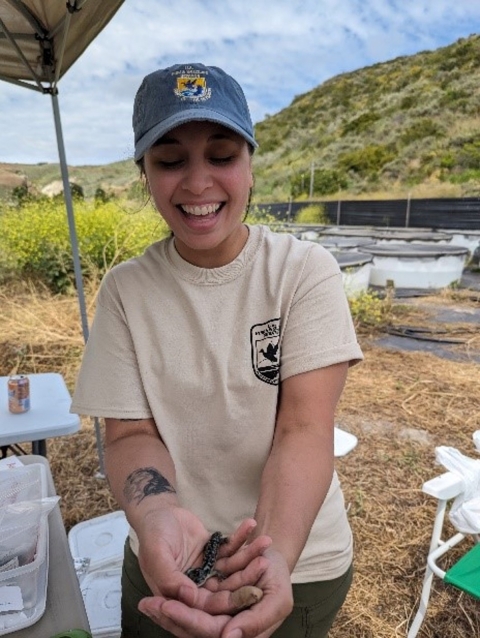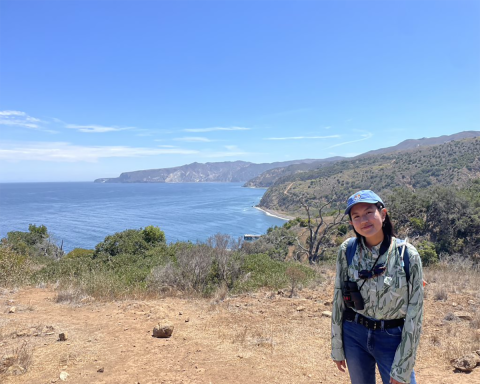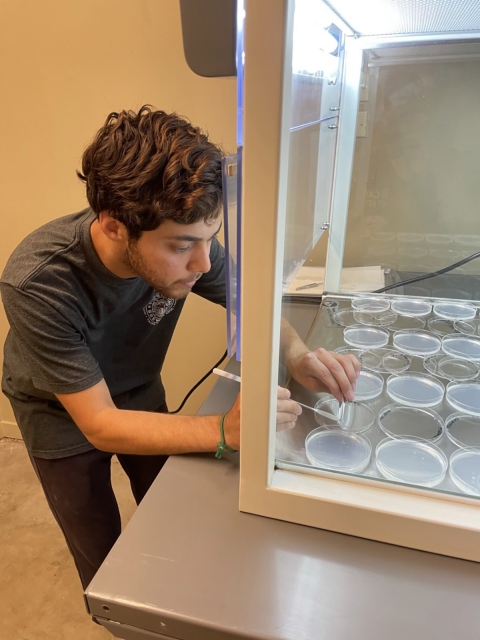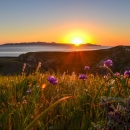States
CaliforniaA Legacy Lives On
Kendra Chan joined the U.S. Fish and Wildlife Service through the Directorate Fellows Program in 2016 after graduating from the University of California, Davis. She went on to serve as a biologist with the Ventura Fish and Wildlife Office until 2019. Kendra and her father Scott Chan, were among the passengers who lost their lives during a dive boat tragedy off the southern California coast in 2019. Kendra left a lasting impact on our agency, and her passion for science and the natural world will never be forgotten.
“Kendra was a remarkable human being. Her positive energy enriched the lives of those she touched through her love of nature, wildlife, and the outdoors. She was a force for good, and led a life that made the world around her a better place. She loved the ocean, from surfing and diving to tide pooling. Her passion, curiosity, and enthusiasm for all living things – from tiny skeleton shrimp to the tidewater goby – were infectious. Not only was she a colleague, but a close friend to many. We miss her dearly, and will carry her energy with us in the days ahead." – Ventura Fish and Wildlife Office
In Kendra’s own words:
https://flic.kr/p/SkByCJ
https://flic.kr/p/FUegYF
The Ventura Fish and Wildlife Office is working with partners and staff from across the agency to honor Kendra’s memory, including developing a fellowship dedicated to preserving Kendra’s conservation legacy for future generations of scientists. In collaboration with the Ecological Society of America, the team has created the Kendra Chan Conservation Fellowship, an annual program that will combine the Service’s Directorate Fellowship Program with the ESA’s Strategies for Ecology Education, Diversity and Sustainability Leadership Development Program to create a unique opportunity for an emerging conservation leader. Our thoughts remain with Kendra’s family, friends, and co-workers as we continue to reflect and honor her life and carry her memory and legacy forward.
Phases of the Program
The Kendra Chan Conservation Fellowship will occur over a two-year period with a conservation project in Year 1 and a focus on professional and leadership development in Year 2.
Phase 1: U.S Fish and Wildlife Service - Directorate Fellow Program
The Directorate Fellows Program (DFP) is an 11-week fellowship working on projects that support FWS conservation priorities. The 11-week fellowships begin in mid-May/mid-June and end in August/September each year. Upon completion of the Kendra Chan Conservation Fellowship and with receipt of a post-secondary degree, the fellow would earn direct hire authority to the U.S. Fish and Wildlife Service for 2 years.
- Oct-Dec Year 1: Recruitment of Kendra Chan Fellow
- Jan-Feb Year 1: Selection of Kendra Chan Fellow
- May or June Year 1: NCTC Orientation Kendra Chan Fellow and National DFPs
- May-Aug Year 1: Student will work with USFWS on a summer research project to be able to present the findings at the ESA Annual Meeting.
- August Year 1: End of DFP fellowship
Phase 2: Ecological Society of America (ESA)-Strategy for Ecology Education, Diversity, and Sustainability (SEEDS)
The SEEDS Partnerships For Undergraduate Research (SPUR) Fellowship is the highest honor in the SEEDS program, and fellows are encouraged to be the outstanding leaders in the future of ESA. The Fellowship supports the undergraduate student in designing and conducting an ecology research project of their interest. Click here to learn more.
- May Year 1: First call with SPUR Fellows
- June Year 1: Second call with SPUR Fellows
- Fall Year 1: Student will travel to attend the ESA-SEEDS Leadership Meeting
- November Year 1: Third call with SPUR Fellows
- February Year 2: Student must submit research abstract to present at the Year 2 ESA Annual Meeting
- Spring Year 2: Student will travel to attend a ESA-SEEDS National Field Trip
- June Year 2: Final call with SPUR Fellows
- August Year 2: Student will present the research at the Year 2 ESA Annual Meeting and receive their SPUR Fellowship completion award.
Eligibility Requirements
- Open for consideration to both undergraduate and graduate students who will not complete their degree requirements before September 22nd, 2024
- Cumulative GPA must be 3.0 or higher
- US citizen or permanent resident
- Demonstrated interest, education, and/or experience in conservation
- Must be available for 12 weeks (1-week orientation plus 11-week fellowship) and available for travel to two ESA workshops and annual conference
- Must be able to pass a criminal background check
- Must be 17 years of age or older
Benefits
- Housing and travel allowance provided
- Hands-on experience
- 1-week Orientation at the FWS National Conservation Training Center, Shepherdstown, WV
- Fellows may be eligible for a permanent position in the FWS after successfully completing their fellowship and degree requirements
- Opportunities to network with conservation professionals from across the country
- Participation in ESA's leadership development workshops and opportunity to present research at annual ESA conference
2024 Kendra Chan Conservation Fellow: Max Tcheng
“I believe breaking down barriers and bringing people together from diverse backgrounds gives us the best chance of helping our environment. In my future work, I hope to intentionally work with holders of diverse knowledge to further conservation efforts and increase collaboration between everyone who has something to say about it, and everyone who might have wisdom that could help,” said Max Tcheng, the Ventura office's 2024 Kendra Chan Conservation Fellow.
The focus of Max’s project is habitat analysis for the Ohlone tiger beetle. Last year he completed the UC Santa Cruz CITRIS Initiative for Drone Education and Research program, which teaches students airspace regulations, how to fly drones, and provides real drone project experience. “The program inspired me to think about the potential applications of drones in my projects, like habitat analysis for my current project. Seeing the potential for this technology to do so much good in the world inspires me to keep learning and be a proponent for drone applications.”
2023 Kendra Chan Conservation Fellow: Felicia Aasand
Felicia Aasand and her Australian shepherd can often be spotted hiking and backpacking in her free time. She spent her summer in Ventura, California as the third Kendra Chan Conservation Fellow, where she collected pre-restoration data at five locations for planting milkweeds. She also participated in bird point count surveys, and plant and monarch surveys with her team while learning about what these locations are like before planting milkweeds.
"I am so grateful to be a Kendra Chan Conservation Fellow," says Aasand. "Although I never met her, I feel so connected to her, and grateful to have been chosen to carry on her legacy."
Read more about Felicia's experience as a Kendra Chan Conservation Fellow.
2022 Kendra Chan Conservation Fellow: Celeste Chen
On a typical weekend you can find Celeste Chen exploring local rivers in their home state of Texas, reading books, practicing yoga, and dreaming of opening their own studio filled with art depicting the beauty of the outdoors where they draw inspiration.
This summer, Chen, an undergraduate at Texas State University in San Marcos, traveled to California to join the U.S. Fish and Wildlife Service as the agency’s second Kendra Chan Conservation Fellow, to study the presence of pesticides on populations of narrowleaf milkweed plants, a critical host plant for monarch butterflies, in Southern California.
Read more about Celeste's experience as a Kendra Chan Conservation Fellow.
Check out an infographic created by Celeste that depicts native California nectar plants that we can plant to support pollinators.
2021 Kendra Chan Conservation Fellow: Daniel Cisneros
Daniel Cisneros stood atop one of the highest peaks on Santa Rosa Island off the California coast, admiring the island oak and bishop pine trees, an ancient forest among the clouds brought back to life after years of human disturbance.
Cisneros, an ecology student at the University of California, Santa Barbara, is working with the U.S. Fish and Wildlife Service and Santa Barbara Botanic Garden to conduct a germination study for five rare plant species on the Channel Islands. The work will shed light on the role seed banking can play to help struggling plant populations.
Read more about Daniel's experience as a Kendra Chan Conservation Fellow.
Take a look at a story map created by Daniel that gives a history of rare plants on the Channel Islands and current conservation strategies to prevent their extinction
.







